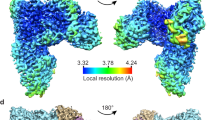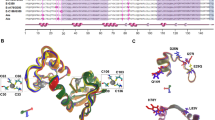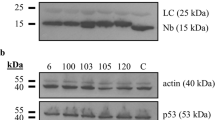Abstract
It has recently been shown that the high-risk human papillomavirus (HPV) E6 proteins can target the PDZ-domain containing proteins, Dlg, MUPP-1, MAGI-1 and hScrib for proteasome-mediated degradation. However, the E6 proteins from HPV-16 and HPV-18 (the two most common high-risk virus types) differ in their ability to target these proteins in a manner that correlates with their malignant potential. To investigate the underlying mechanisms for this, we have mutated HPV-16 and HPV-18 E6s to give each protein the other's PDZ-binding motif. Analysis of these mutants shows that the greater ability of HPV-18 E6 to bind to these proteins and to target them for degradation is indeed due to a single amino acid difference. Using a number of assays, we show that the E6 proteins interact specifically with only one of the five PDZ domains of MAGI-1, and this is the first interaction described for this particular PDZ domain. We also show that the guanylate kinase homology domain and the regions of MAGI-1 downstream of amino acid 733 are not required for the degradation of MAGI-1. Finally, in a series of comparative analyses, we show that the degradation of MAGI-1 occurs through a different mechanism from that used by the E6 protein to induce the degradation of Dlg and p53.
This is a preview of subscription content, access via your institution
Access options
Subscribe to this journal
Receive 50 print issues and online access
$259.00 per year
only $5.18 per issue
Buy this article
- Purchase on Springer Link
- Instant access to full article PDF
Prices may be subject to local taxes which are calculated during checkout








Similar content being viewed by others
References
Banks L, Matlashewski G, Crawford L . 1986 Eur. J. Biochem. 159: 529–534
Bilder D, Li M, Perrimon N . 2000 Science 289: 113–116
Craven S, Bredt D . 1998 Cell 93: 495–498
Crook T, Tidy J, Vousden K . 1991a Cell 67: 547–556
Crook T, Wrede D, Vousden KH . 1991b Oncogene 6: 873–875
Dobrosotskaya I, Guy R, James G . 1997 J. Biol. Chem. 272: 31589–31597
Dobrosotskaya I, James G . 2000 Biochem. Biophys. Res. Commun. 270: 903–909
Downward J . 1998 Curr. Opin. Cell Biol. 10: 262–267
Fanning A, Anderson J . 1999 J. Clin. Invest. 103: 767–772
Franke T, Kaplan D, Cantley L, Toker A . 1997 Science 275: 665–668
Gardiol D, Banks L . 1998 J. Gen. Virol. 79: 1963–1970
Gardiol D, Kühne C, Glaunsinger B, Lee S, Javier R, Banks . 1999 Oncogene 18: 5487–5496
Glaunsinger B, Lee S, Thomas M, Banks L, Javier R . 2000 Oncogene 19: 5270–5280
Gomperts S . 1996 Cell 84: 659–662
Gross-Mesilaty S, Reinstein E, Bercovich B, Tobias K, Schwartz A, Kahana C, Ciechanover A . 1998 Proc. Natl. Acad. Sci. USA 95: 8058–8063
Huibregtse J, Scheffner M, Howley P . 1991 EMBO. J. 10: 4129–4135
Huibregtse J, Scheffner M, Howley P . 1993 Mol. Cell. Biol. 13: 775–784
Ide N, Hata Y, Nishioka H, Hirao K, Yao I, Deguchi M, Mizoguchi A, Nishimori H, Tokino T, Nakamura Y, Takai Y . 1999 Oncogene 18: 7810–7815
Kim E, DeMarco S, Marfatia S, Chishti A, Sheng M, Strehler E . 1998 J. Biol. Chem. 273: 1591–1595
Kim S . 1997 Curr. Opin. Cell Biol. 9: 853–859
Kiyono T, Hiraiwa A, Fujita M, Hayashi Y, Akiyama T, Ishibashi M . 1997 Proc. Natl. Acad. Sci. USA 94: 11612–11616
Klippel A, Reinhard C, Kavanaugh W, Apell G, Escobedo M, Williams L . 1996 Mol. Cell Biol. 16: 4117–4127
Lee S, Weiss R, Javier R . 1997 Proc. Natl. Acad. Sci. USA 94: 6670–6675
Lee S, Glaunsinger B, Mantovani F, Banks L, Javier R . 2000 J. Virol. 74: 9680–9693
Li J, Simpson L, Takahashi M, Miliaresis C, Myers M, Tonks N, Parsons R . 1998 Cancer Res. 56: 5667–5672
Li X, Coffino P . 1996 J. Virol. 70: 4509–4516
Marte B, Downward J . 1997 Trends Biochem. Sci. 22: 355–358
Marte B, Rodriguez-Vinciana P, Wennstrom S, Warne P, Downward J . 1997 Curr. Biol. 7: 63–70
Mietz J, Unger T, Huibregtse J, Howley P . 1992 EMBO J. 11: 5013–5020
Mitic L, Anderson J . 1998 Annu. Rev. Physiol. 60: 121–142
Nakagawa S, Huibregtse J . 2000 Mol. Cell Biol. 21: 8244–8253
Patrie KM, Drescher AJ, Goyal M, Wiggins RC, Margolis B . 2001 J. Am. Soc. Nephrol. 12: 667–677
Pim D, Storey A, Thomas M, Massimi P, Banks L . 1994 Oncogene 9: 1869–1876
Pim D, Thomas M, Javier R, Gardiol D, Banks L . 2000 Oncogene 19: 719–725
Polakis P . 1999 Curr. Opin. Genet. Dev. 9: 15–21
Ponting C, Phillips C . 1995 Trends Biochem. Sci. 20: 102–103
Saras J, Heldin C . 1996 Trends Biochem. Sci. 21: 455–458
Scheffner M, Werness B, Huibregtse J, Levine A, Howley P . 1990 Cell 63: 1129–1136
Scheffner M, Munger K, Byrne JC, Howley PM . 1991 Proc. Natl. Acad. Sci. USA 88: 5523–5527
Songyang Z, Fanning A, Fu C, Xu J, Marfatia S, Chisti A, Crompton A, Chan A, Anderson J, Cantley L . 1997 Science 275: 73–77
Stambolic V, Suzuki A, de al Pompa J, Brothers G, Mirtsos C, Sasaki T, Ruland J, Penninger J, Siderovski D, Mak T . 1998 Cell 95: 29–39
Tashiro H, Blazes M, Wu R, Cho K, Bose S, Wang S, Li J, Parsons R, Ellenson L . 1997 Cancer Res. 57: 3935–3940
Thomas M, Banks L . 1998 Oncogene 17: 2943–2954
Thomas M, Banks L . 1999 J. Gen. Virol. 80: 1513–1517
Thomas M, Massimi P, Jenkins J, Banks L . 1995 Oncogene 10: 261–268
Weiss R, Gold M, Vogel H, Javier R . 1997 J. Virol. 71: 4385–4394
Wu X, Hepner K, Castelino-Prabhu S, Do D, Kaye M, Yuan X, Wood J, Ross C, Sawyers C, Whang Y . 2000a Proc. Natl. Acad. Sci. USA 97: 4233–4238
Wu Y, Dowbenko D, Spencer S, Laura R, Lee J, Gu Q, Laskey L . 2000b J. Biol. Chem. 275: 21477–21485
Acknowledgements
This work was supported in part by a grant from the Associazione Italiana per Ricerca sul Cancro to L Banks and grant number RO1 CA58541 from the National Institutes of Health to R Yavier.
Author information
Authors and Affiliations
Rights and permissions
About this article
Cite this article
Thomas, M., Glaunsinger, B., Pim, D. et al. HPV E6 and MAGUK protein interactions: determination of the molecular basis for specific protein recognition and degradation. Oncogene 20, 5431–5439 (2001). https://doi.org/10.1038/sj.onc.1204719
Received:
Revised:
Accepted:
Published:
Issue Date:
DOI: https://doi.org/10.1038/sj.onc.1204719
Keywords
This article is cited by
-
The polymorphism analysis and epitope predicted of Alphapapillomavirus 9 E6 in Sichuan, China
Virology Journal (2022)
-
Genetic variability of human papillomavirus type 39 based on E6, E7 and L1 genes in Southwest China
Virology Journal (2021)
-
Immune Escape and Immunotherapy of HPV-Related Oropharyngeal Cancer: Has the Future Arrived?
Current Otorhinolaryngology Reports (2015)
-
Transcriptomic analyses of genes differentially expressed by high-risk and low-risk human papilloma virus E6 oncoproteins
VirusDisease (2015)
-
Analysis of the PDZ binding specificities of Influenza A Virus NS1 proteins
Virology Journal (2011)



